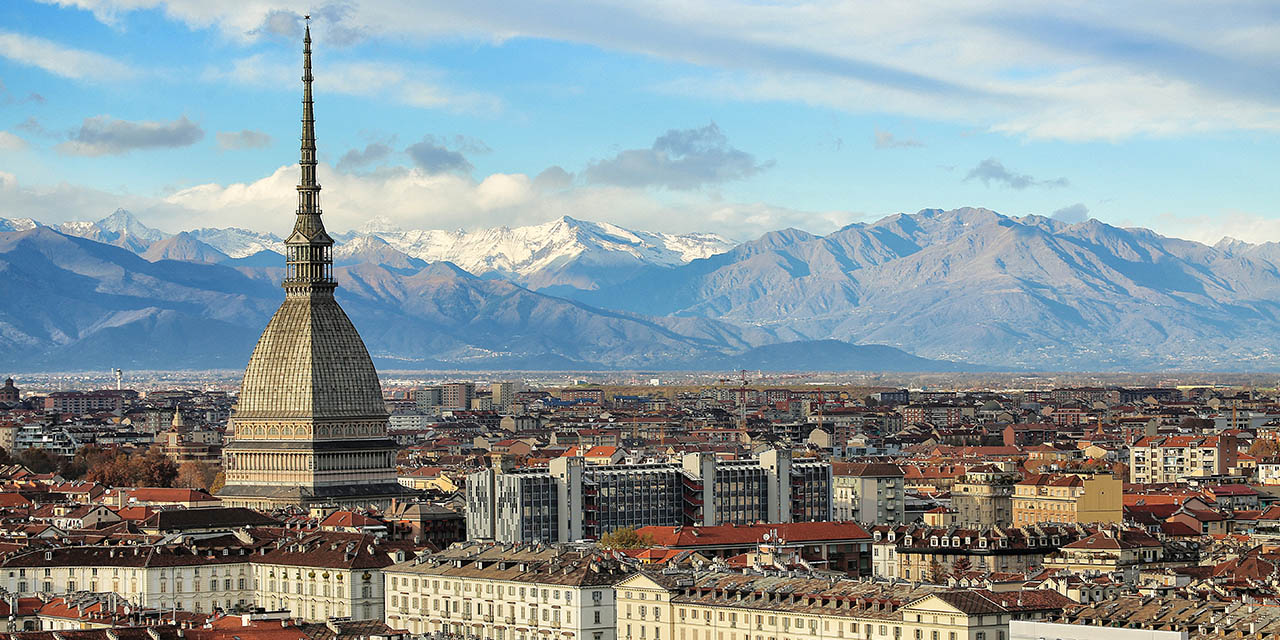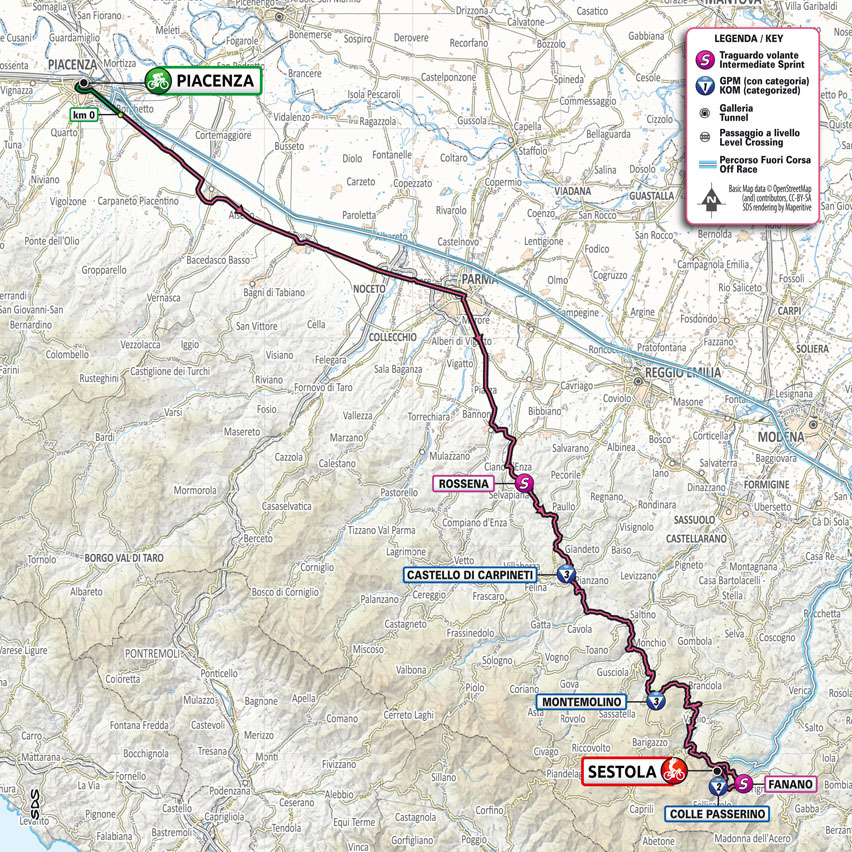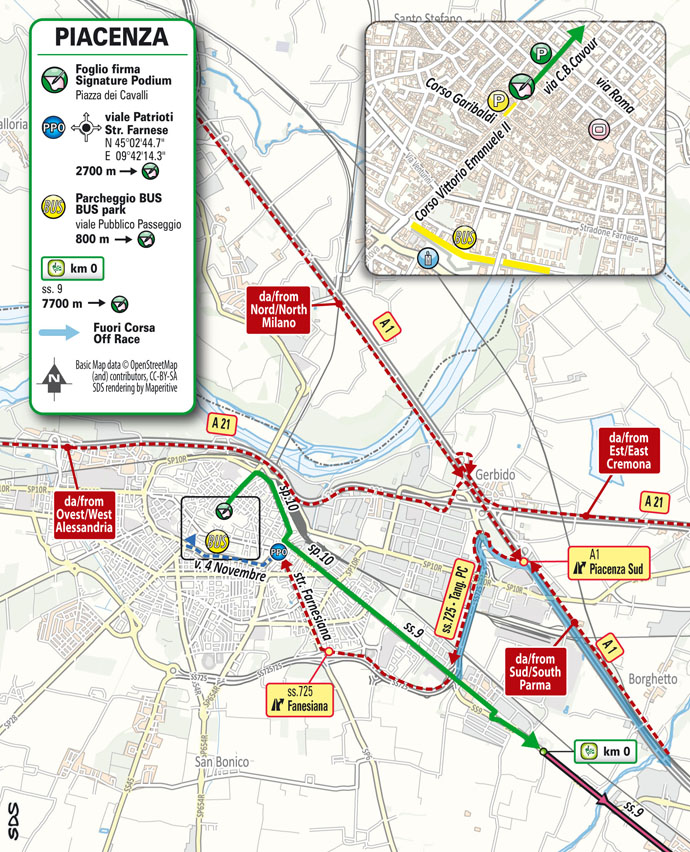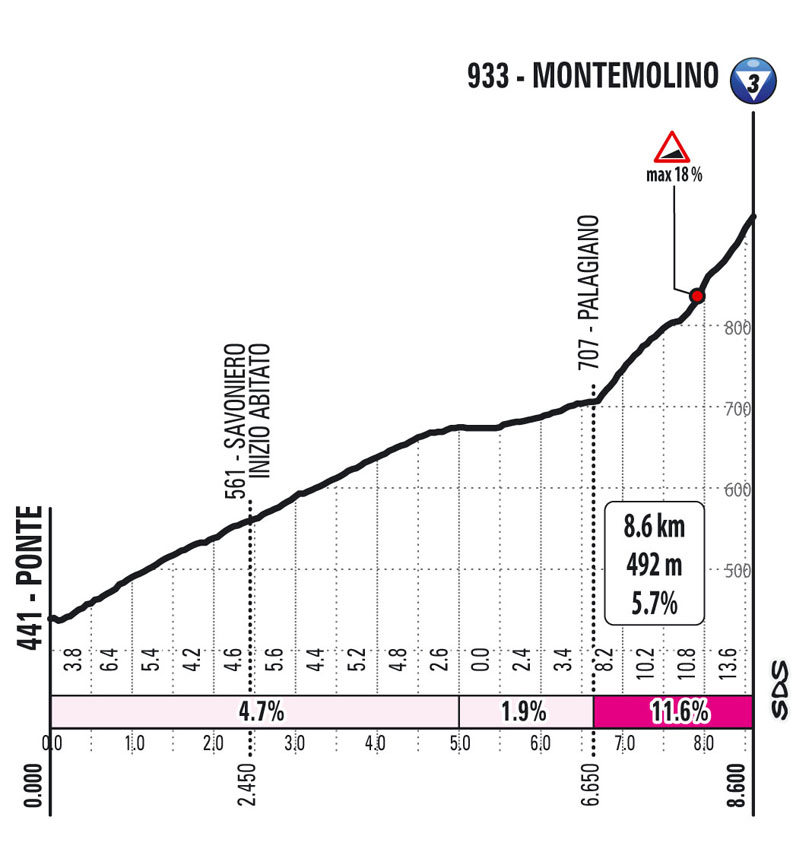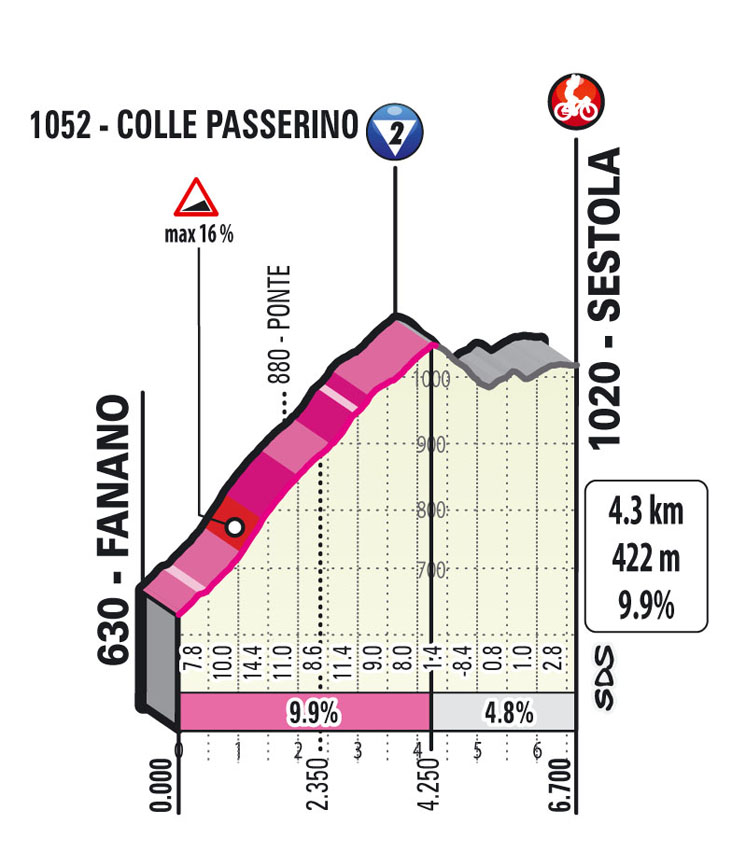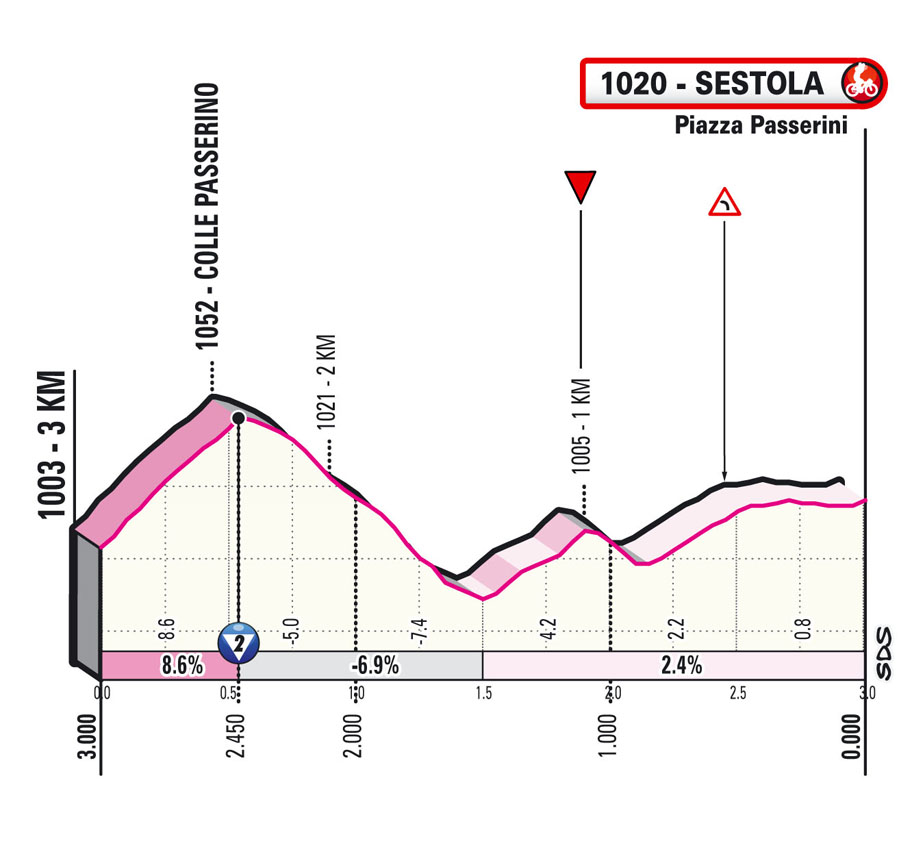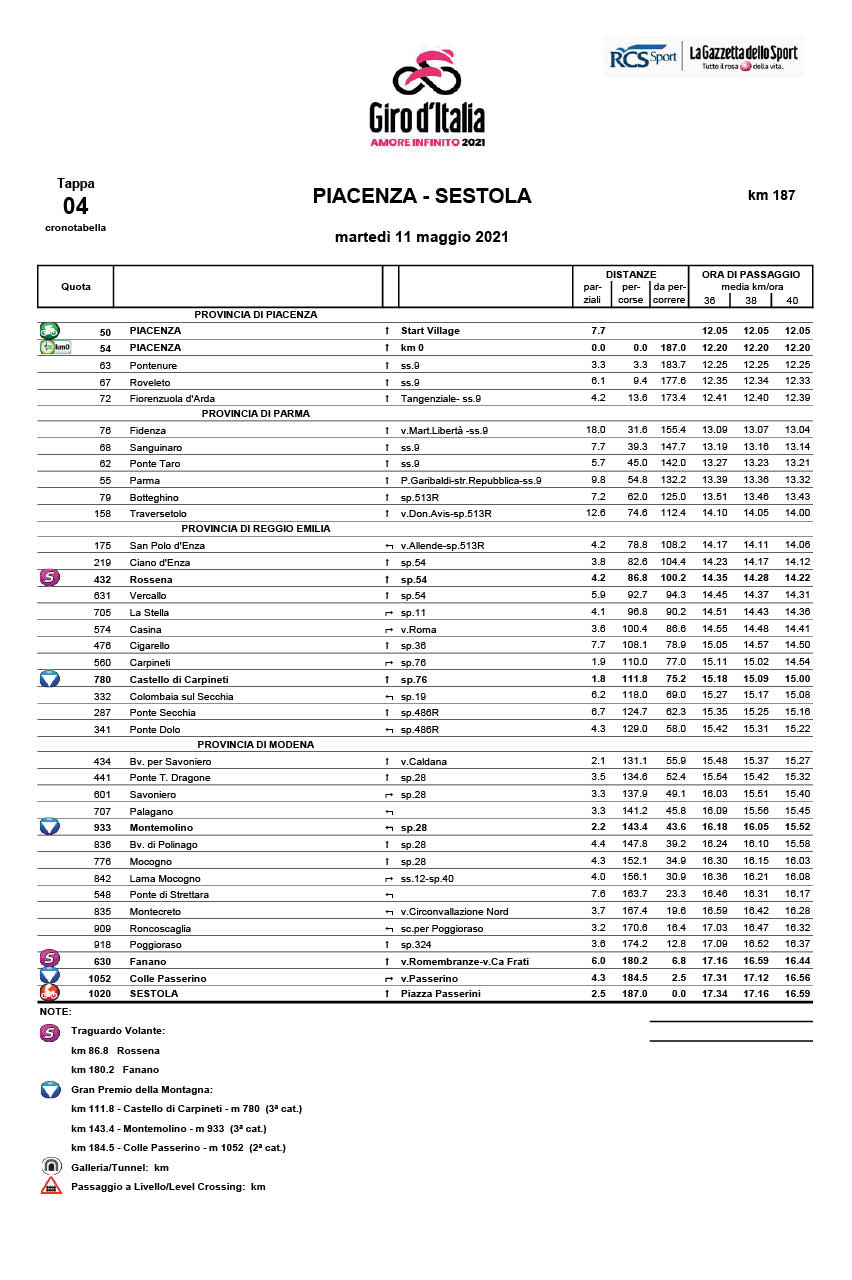profile
map
technical info
The stage is clearly divided into two parts: flat and straight along the Via Emilia, all the way to Parma, wavy and technical afterwards. Past Parma, the route takes in a brace of ascents (including two categorised climb), with gradients exceeding 10% at points, on relatively narrow roads. Past Montecreto and Fanano, the route takes in the Colle Passerino climb, which ends at 2 km out.
Final kilometres
The last 6 km are very demanding. Starting in Fanano, the Colle Passerino climb runs on narrowed roadway, with gradients exceeding 10% over extended stretches, and lengthy peaks topping out at 13-14%. At the ‑2 km mark, the road descends for approx. 800 metres and then rises again with easy gradients. The route runs on setts from ‑750 m to ‑250 m, while the finish sits on tarmac.
start / finish
climb detail
final kilometres
itinerary timetable
tourist info
Host city:
Piacenza
Overview
“Piacenza is a land of passage”, Leonardo Da Vinci wrote in his “Codex Atlanticus”.
Located at the junction of four different regions, on the southern bank of the river Po, the city is the gate of Emilia, surrounded by the hills and mountains of the Apennines. Founded as a Roman colony, Piacenza acquired great importance in Medieval times, always representing an ideal rest area for princes and pilgrims, crusaders and templars, tradesmen and artists who left their mark along the way.
A warm hospitality is part of Piacenza’s identity, enclosed in the words “Crossroads of cultures” chosen as the symbol of an intense cultural, artistic and promotional series of events.
The heart of the historical town lies in its main square, Piazza Cavalli, which bears the name of the two equestrian monuments by Francesco Mochi, dating back to 1625, dedicated to Alessandro and Ranuccio Farnese. Palazzo Gotico, the impressive Municipal palace built in 1281, dominates the scene. Wandering around the streets in the city centre, visitors encounter innumerable ancient churches and historical residential palaces that make Piacenza a treasure chest to discover and appreciate, along with the excellence of its food and wine.
Gastronomy
There are two sides to the soul of Piacenza’s culinary tradition, both tied to its geographical location. On one hand, variety: bordering with three different regions such as Lombardy, Liguria and Piedmont, constant exchanges have enriched the heritage of this land, known since ancient times for its good food and wine. On the other hand, Piacenza’s specialities can well be considered typically Emilian, embodying the traits of delicacy and abundance that have made this region famous all over the world.
Also the nearby hills and mountains are the cradle of extraordinary products: mushrooms, chestnuts and game, not to mention the top quality cultivations reaching the outskirts of the city.
Several dishes have overcome the boundaries of the province and are considered a classic of the Italian tradition: “pisarei e fasö” (small dumplings made of flour and breadcrumbs, with a bean sauce dressing) or “anolini in brodo” (home-made pasta with a cheese and stew filling, served in broth). Piacenza can also boast excellent DOP products, certified for their quality and area of origin; two kinds of cheese, Grana Padano and Provolone Valpadana, along with three types of cured meat: pancetta, coppa and salame.
Many other specialities are worth the journey and deserve to be tasted, such as the “rice bomb”, the “tailed tortelli” and countless local recipes based on freshwater fish, frogs and snails, without forgetting luscious roasts and a rich variety of desserts.
Drinks
The perfect combination for the excellent food in Piacenza is a bottle of wine: the whole province can boast a rich and varied wine production, cradled especially on the hillside. Gutturnio is the widely known red wine resulting from the blend of Barbera and Croatina (Bonarda), appreciated in all its varieties – still, sparkling and reserve – accompanying innumerable dishes and local specialities.
However, several wine varieties deserve to see their quality and special characteristics valued and enhanced. Among the red wines, one must mention at least Pinot nero, Barbera and Merlot, whilst Ortrugo, albeit not counting on an exstensive production, is the only native white variety. The latter counts also on Malvasia, both dry and sweet, in its aromatic Candia tradition, the historical roots of which date back to Leonardo Da Vinci. White wines show multiple varieties, from still to sparkling, not to forget spumante types. The whole range of choices is impressive: entire menus of typical food, from starters to dessert, could find their perfect combination in local wines.
Main sights
As mentioned above, Piacenza is a “crossroads of cultures”, a treasure chest showing its contents among the characteristic, narrow streets of the city centre. Wandering through the old town, not only Palazzo Gotico, Piazza Cavalli and the Farnese equestrian monuments display their magnificence, but many other historical buildings.
In piazza Duomo, the beautiful Cathedral encloses the extraordinary dome frescoed by Morazzone and Guercino. Not far, the impressive Renaissance complex of the Farnese Palace cherishes the heritage of the Civic Museum: not to be missed are the peculiar “Etruscan liver”, used for divinatory purposes and dating back between the II and I century b.C., and the moving tondo by Botticelli, depicting the Virgin and Her Child. Recently, the rich collections of the Museum have been implemented with the Roman section of the Archeological Department, which highlights new details and information on the knowledge of Piacenza’s past.
A few more steps lead us to the Ricci Oddi Gallery of Modern Art, presenting a complete overview on Italian figurative art from the second half of the 19th century onwards. Recently, the world has celebrated the finding of the famous “Portrait of a Lady” by Gustav Klimt, stolen from the same Gallery more than 20 years ago: the masterpiece will be a precious element of promotion and enhancement for the entire collection, which is deemed as one of the most important in Italy.
Our walk through the old town continues towards Santa Maria di Campagna, the magnificent Renaissance basilica planned by architect Alessio Tramello, where the beautiful frescoes by Pordenone adorn the dome. Not to mention the numerous Medieval churches, all of which deserve to be admired: the basilicas of San Francesco, Sant’Antonino, Sant’Eufemia, San Savino and San Sisto, the latter being at the heart of a new interactive exhibition dedicated to the famous “Madonna Sistina” painted by Raffaello in 1512, which it originally hosted and is now exposed in the Gemaldegalerie in Dresden.
Last but not least, let’s end our tour of Piacenza with its Municipal Theatre, neoclassical building inaugurated in 1804, which Stendhal described in 1816 as “one of the most beautiful, actually the most beautiful theatre in Italy”. This comment encloses the extraordinary richness of the cultural, artistic and architectural heritage of Piacenza, a charming city with its relaxed atmospere, its green and elegant landscape embracing the river Po flowing in the spectacular beauty of Nature, only a few steps from the historical centre and beyond, where the hills take us on a fascinating journey trough the quality of life.
Sestola
Overview
Sestola, a renowned winter tourist resort that is easily accessible from Modena, Pistoia and Bologna. The municipal area beyond Lake Ninfa and Passo del Lupo is part of the High Modenese Apennine Regional Park.
Sestola, also known as “The Pearl of the Apennines”, is the most important ski resort in the region because of its proximity to Mount Cimone, the highest mountain in Emilia Romagna and one of the largest of all the Apennines. In the wintertime, Sestola and Mount Cimone are a paradise for all those who love snow related sports such as skiing, snowboarding, cross country skiing, snow-kiting and “ciaspole” (snow shoes).
Gastronomy
You cannot leave without having tasted the traditional speciality “crescentine”, better known as “tigelle” from the name of the ancient tool used to cook it. Crescentine are served with lard and Parmigiano Reggiano cheese which is made by local creameries.
From Crescentine, Borlenghi, Croccante and Ciacci specialities to traditional products such as mushrooms, chestnuts and cheese; the Modena Apennines offer a repertoire of tastes to discover. The traditional local cuisine is unique in blending timeless recipes. All of these products can be purchased from local shops or producers.
Drinks
Lambrusco is certainly the typical wine of excellence of our territory. A red with a strong character but that knows how to enclose the traditions of the Emilian grape varieties. Lambrusco (grasparossa, di Sorbara, salamino) accompanies all dishes of the mountain culinary tradition.
The white wines of our tradition are instead Pignoletto, Montuni and Trebbiano.
Main sights
Living in harmony with the mountains, the environment, the land and local traditions is the experience you can expect when in Sestola for you and/or your entire family. There is something for everyone. To rediscover unpolluted nature in all of its simplicity, you can take advantage of the protected areas of the Park of Frignano and the many lakes and waterfalls present throughout the area.
Sestola is the ideal place to spend free time with its cultural events, tradition and relaxation among the beautiful green Apennine Mountains. In addition to important museums, churches, oratories, villages and old villas, the most interesting attraction is surely the Castle, which includes various museums including one of musical instruments, one of the few in Italy as well as the museum of Ancient Mountain Civilisation.
Do not miss a visit to the Esperia Botanical Garden, ecological education oasis of national importance on the natural flora and Apennine Mountains. It is located inside the Park of Frignano at Passo del Lupo (11 km from Sestola and 1500 meters a.s.l.). In the garden, visitors can see more than two hundred species of indigenous flora and many dozens of plants and flowers that normally grow in the most remote mountain ranges. It also offers an enchanting walk among Alpine and Apennine plants as well as exotic, Himalayan, Tibetan and Arctic species.
After the winter season, Sestola is transformed into a real capital of summer sports. The opportunities are endless, all just waiting to be discovered by those who love outdoor sports. Trekking, orienteering, digiscoping, climbing, canyoning, quads, horseback riding, canoeing, golf, hang gliding, paragliding and lots of trails for mountain bikes are available for those looking to combine fitness and nature. State of the art facilities for football, volleyball, basketball, tennis and swimming are available for those who enjoy more traditional sports.











